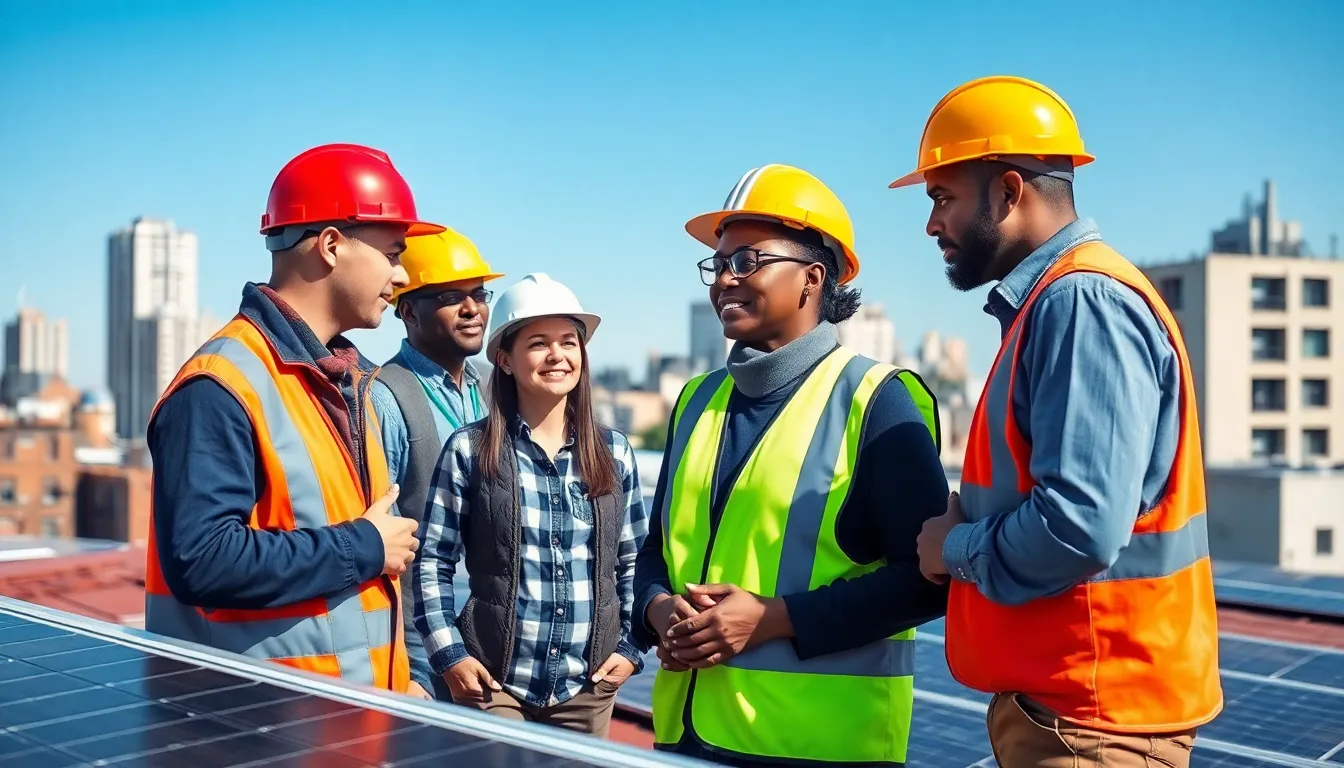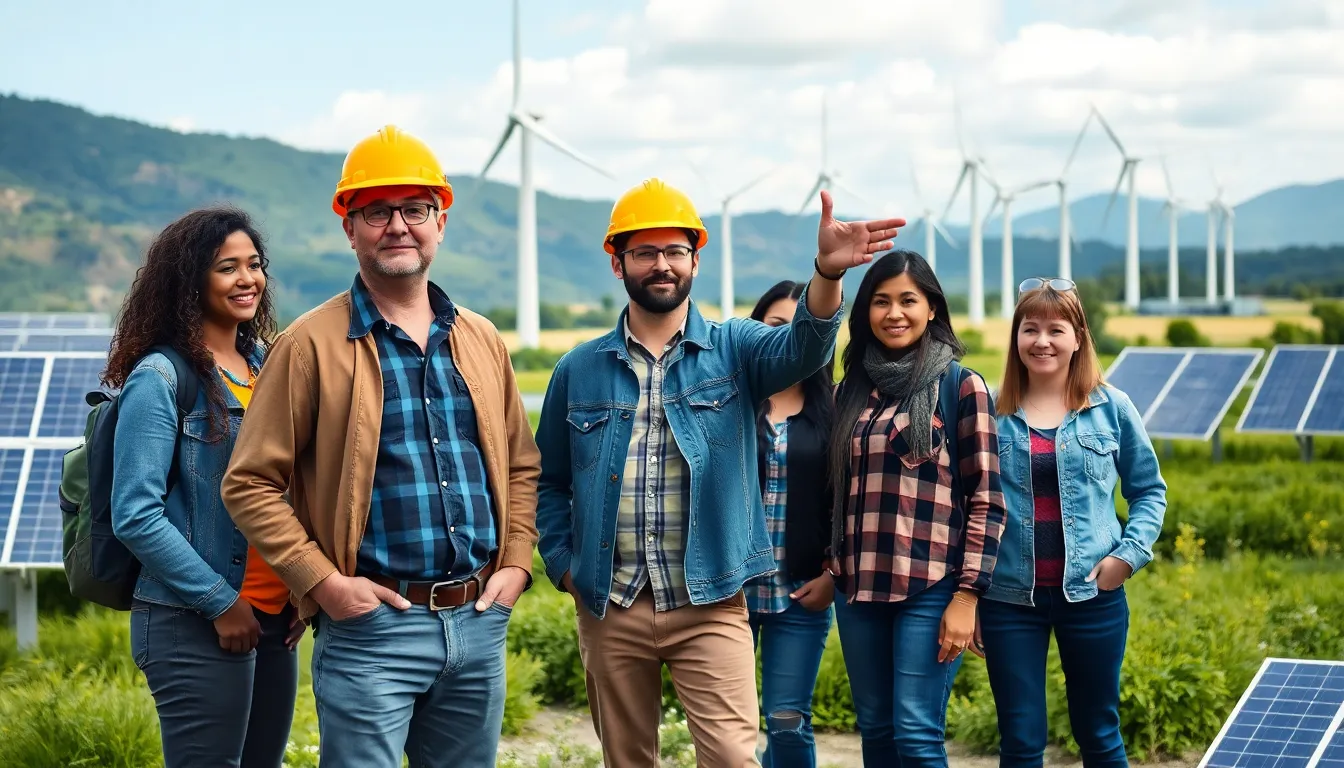In a world where climate change feels like that persistent relative who just won’t leave the party, low-emission building systems are the life-saving bouncers we didn’t know we needed. These innovative solutions not only keep our planet happy but also transform the way we think about construction. Imagine buildings that breathe easy and let the environment thrive—sounds like a dream, right?
With a mix of cutting-edge technology and eco-friendly materials, low-emission systems are paving the way for a greener future. They’re not just a trend; they’re the building blocks of sustainability. So, if you’re ready to build a structure that’s as kind to the Earth as it is to its inhabitants, buckle up. It’s time to dive into the world of low-emission building systems and discover how they can reshape our skylines and our planet for the better.
Table of Contents
ToggleOverview of Low-Emission Building Systems
Low-emission building systems focus on reducing greenhouse gas emissions during construction and throughout a building’s lifecycle. These systems employ innovative technologies and eco-friendly materials, contributing significantly to sustainability.
Applications of low-emission systems include energy-efficient heating, cooling, and ventilation solutions. One common approach is utilizing renewable energy sources such as solar panels and wind turbines, which dramatically lower a building’s carbon footprint.
Insulation materials also play a key role in these systems. High-performance insulation minimizes energy consumption by reducing the need for heating and cooling. Additionally, energy-efficient windows minimize heat loss, enhancing overall energy efficiency.
Building management systems enhance operational efficiency. Advanced controls allow for the optimization of energy consumption in real-time. Connecting various building systems helps monitor and reduce energy usage, making the buildings smarter and much more sustainable.
Low-emission building certifications represent another critical aspect. Certifications like LEED and BREEAM encourage the adoption of sustainable practices and reward projects meeting strict emission standards. These programs offer a framework for builders aiming to reduce environmental impact.
Ultimately, the integration of low-emission building systems leads to healthier environments for occupants. Improved air quality and reduced exposure to toxic materials enhance occupant comfort and productivity. As awareness of climate change grows, these systems become increasingly essential for future construction projects, paving the way for greener urban landscapes.
Types of Low-Emission Building Systems
Low-emission building systems incorporate various technologies and strategies aimed at significantly reducing environmental impact. These systems play a crucial role in sustainable construction practices.
Renewable Energy Integration
Integrating renewable energy sources forms a vital component of low-emission building systems. Solar panels provide clean energy, significantly cutting electricity costs. Wind turbines contribute additional energy generation, especially in suitable locations. These sources minimize reliance on fossil fuels, reducing greenhouse gas emissions. Incorporating geothermal heating or cooling systems also enhances efficiency by utilizing the earth’s stable temperature for climate control. Battery storage technology allows for effective energy management, ensuring availability during peak demand. This integration supports a building’s energy autonomy while promoting a sustainable lifestyle.
Efficient Heating and Cooling Solutions
Efficient heating and cooling systems represent another key aspect of low-emission building systems. Heat pumps utilize electricity to transfer heat rather than generate it, reducing energy consumption. Radiant heating systems maintain comfort using lower temperature water and minimizing waste. Smart thermostats optimize temperature regulation, adjusting based on occupancy patterns. Utilizing high-performance insulation and energy-efficient windows reduces heating and cooling demands. Advanced ventilation systems improve indoor air quality while maximizing energy efficiency. Implementing these solutions curtails energy use and enhances occupant comfort.
Benefits of Low-Emission Building Systems
Low-emission building systems provide significant advantages for both the environment and economic landscapes. Their adoption paves the way for sustainable construction practices that benefit society at large.
Environmental Impact
Low-emission building systems drastically reduce greenhouse gas emissions. They utilize renewable energy sources like solar panels and wind turbines, effectively decreasing reliance on fossil fuels. Energy-efficient technologies, including advanced insulation and smart ventilation, lower energy consumption. Improved indoor air quality emerges from efficient heating and cooling solutions, contributing to healthier living spaces. Incorporating these systems aligns with global climate goals, supporting the transition to low-carbon economies.
Economic Advantages
Economic benefits accompany the implementation of low-emission building systems. Reduced energy consumption translates into lower utility bills for occupants, enhancing affordability. Additionally, properties built using sustainable practices often attract higher market values. Incentives and tax rebates related to eco-friendly building decisions decrease initial investment costs. Long-term operational savings result from lower maintenance requirements associated with efficient systems, promoting overall financial sustainability in building projects.
Challenges in Implementation
Implementing low-emission building systems presents various challenges that can hinder progress toward sustainability in construction.
Regulatory Hurdles
Regulatory hurdles often complicate the adoption of low-emission building systems. Zoning laws may not easily accommodate innovative designs that utilize advanced technologies. Compliance with existing building codes can require extensive modifications, which increase project timelines. Additionally, securing necessary permits may involve lengthy processes that stall implementation. Local regulations can vary significantly, adding complexity for developers. Navigating these regulatory landscapes can deter developers from pursuing low-emission systems despite their benefits.
Initial Costs
Initial costs represent a significant barrier to the implementation of low-emission building systems. Although these systems lead to long-term savings, upfront investments often remain high. Advanced technology, such as energy-efficient heating and cooling systems, frequently requires substantial capital. Eco-friendly materials can also carry premium price tags compared to conventional options. Financial institutions may not always recognize the long-term value, limiting access to necessary funding. Despite these financial challenges, the long-term benefits and potential incentives still position low-emission systems as a worthwhile investment.
Future Trends in Low-Emission Building Systems
Emerging technologies promise to reshape low-emission building systems significantly. Smarter building materials gain traction as they improve energy efficiency and indoor air quality. Innovations in self-healing concrete, for example, can extend a structure’s lifespan and reduce maintenance costs.
Building-integrated photovoltaics (BIPV) gain popularity, seamlessly combining energy generation and aesthetics. These systems allow buildings to generate energy without compromising design. Growth in advanced energy storage solutions also enhances energy resilience. These batteries, paired with renewable sources, provide reliable power during peak demand periods.
Smart building management systems continue to evolve, leveraging the Internet of Things (IoT) to optimize energy use in real time. Adaptive systems monitor occupancy and adjust heating and cooling accordingly, promoting comfort while minimizing waste. Increased integration of artificial intelligence in building operations leads to more predictive maintenance and energy management.
Sustainable certifications, like LEED and BREEAM, adapt to reflect advancements in technology and materials. Updated criteria encourage developers to embrace innovative practices, paving the way for broader adoption of low-emission systems. Regional incentives further incentivize compliance, making eco-friendly choices financially attractive.
A notable trend involves modular construction techniques, which reduce waste and construction time. These prefabricated systems not only enhance efficiency but also minimize on-site environmental impact. Trends in biophilic design also gain momentum, emphasizing the incorporation of nature within built environments for improved occupant well-being.
In this rapidly evolving landscape, collaboration among stakeholders becomes crucial. Architects, engineers, and developers must work together to integrate new technologies effectively. Future low-emission building systems are poised to lead the transition toward sustainable urban environments, significantly reducing carbon footprints.
Conclusion
Low-emission building systems are transforming the construction landscape by prioritizing sustainability and energy efficiency. Their innovative technologies and eco-friendly materials not only reduce greenhouse gas emissions but also enhance occupant comfort and air quality. As the industry faces challenges such as regulatory hurdles and initial costs, the long-term benefits make these systems a valuable investment for the future.
Emerging trends and advancements in building technologies promise to further elevate the role of low-emission systems in creating greener urban environments. Collaboration among industry professionals will be essential in harnessing these innovations, ensuring that low-emission building systems remain at the forefront of sustainable construction practices. The commitment to eco-friendly solutions is paving the way for a healthier planet and more resilient communities.







